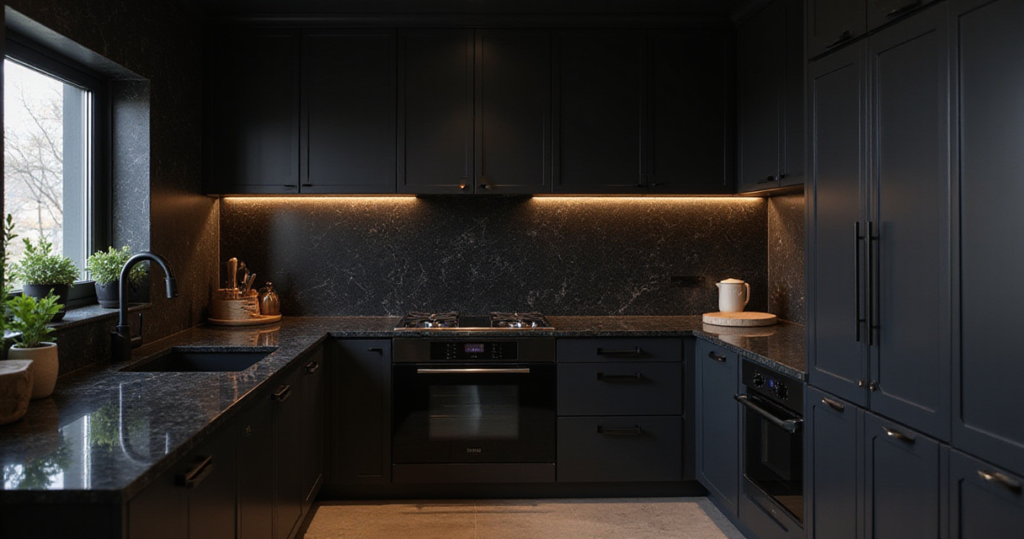In the West, we often see the kitchen as the bright, bustling heart of the home. But there is a quiet wisdom in turning toward the profound depth of black. In Japanese aesthetics, black is not an absence of color. It is a presence. It holds elegance, a sense of mystery, and the limitless potential we find in shadows.
A kitchen cloaked in black draws on the principle of shibui—an unobtrusive, understated beauty that deepens and becomes more appealing as you live with it. This isn’t about creating an oppressive space. It’s about cultivating an intimate sanctuary. I’ve seen firsthand how the right balance of light and shadow can turn a purely functional room into something akin to visual poetry. Against this deep backdrop, the smallest details—the grain of charcoal-stained wood, the soft glint of a brass handle—are given a new, heightened meaning.
These ideas are more than just a trend; they are pathways to creating a space that feels both dramatically modern and timelessly serene. They are an invitation to see how darkness can illuminate, how less can become so much more, and how the careful arrangement of material and light can make your kitchen a place of quiet, understated elegance.
1. Embrace the Monochromatic Harmony of All-Black Design
An all-black kitchen can be the ultimate expression of kanso—the deep beauty found in simplicity and the elimination of what is not essential. It’s a brave choice, I admit. I once had a client who was terrified of the idea, imagining a dark cave. But when we were done, they were stunned by how the space felt both boundless and intimate. When every surface speaks the same language, the room takes on a meditative quality.
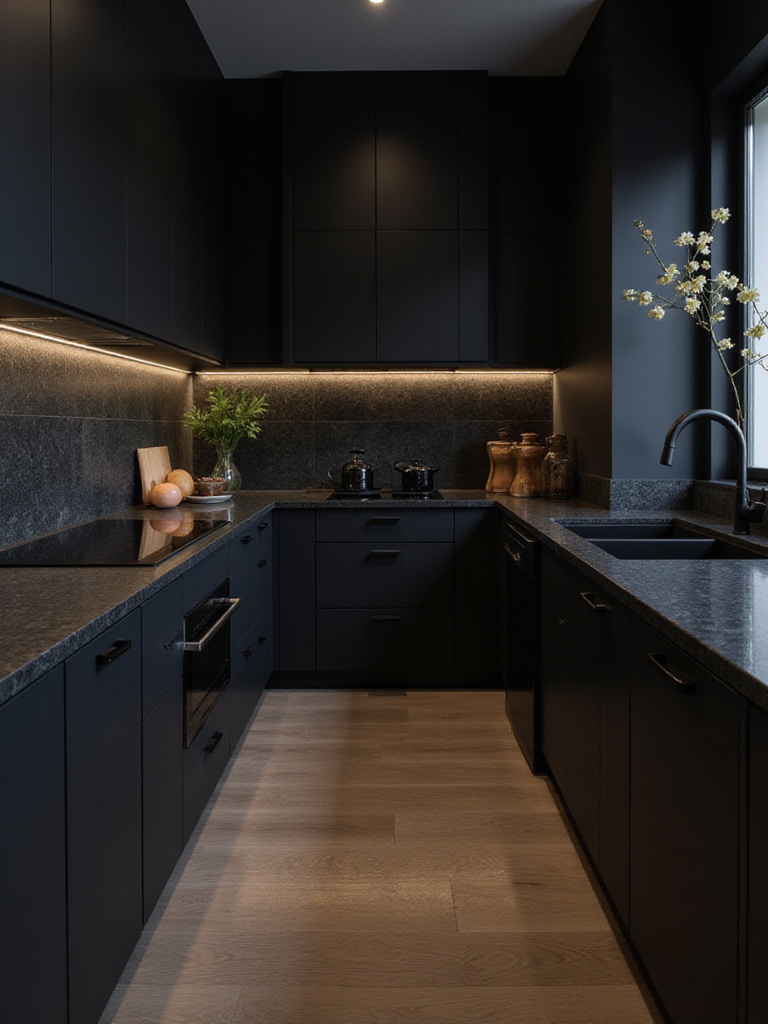
This is the paradox of a well-designed black space. Black surfaces have a way of receding, which can create an illusion of a larger area. At the same time, they foster an enveloping, cocoon-like feeling. This reflects the Japanese concept of ma, the idea that negative space is an active and essential part of any composition. An all-black palette isn’t just for looks; it creates a visual continuity that makes even a small kitchen feel more organized and expansive. The key is to avoid flatness by layering different black finishes—matte, polished, textured—and using strategic lighting to carve out dimension.
What I find most compelling here is how texture, not color, becomes the primary language of the room. It asks you to look closer, to notice the subtle differences between surfaces, which is a very contemplative way to experience a space.
2. Balance Darkness with Natural Wood’s Organic Warmth
Bringing natural wood into a black kitchen is where the design truly starts to breathe. This pairing is a perfect example of wabi-sabi, the art of finding beauty in the harmony of contrasts and the perfection of imperfection. Black provides a strong, silent structure, while the wood introduces the warmth and irregular patterns that connect us to the natural world. It’s what keeps a modern kitchen from feeling sterile.
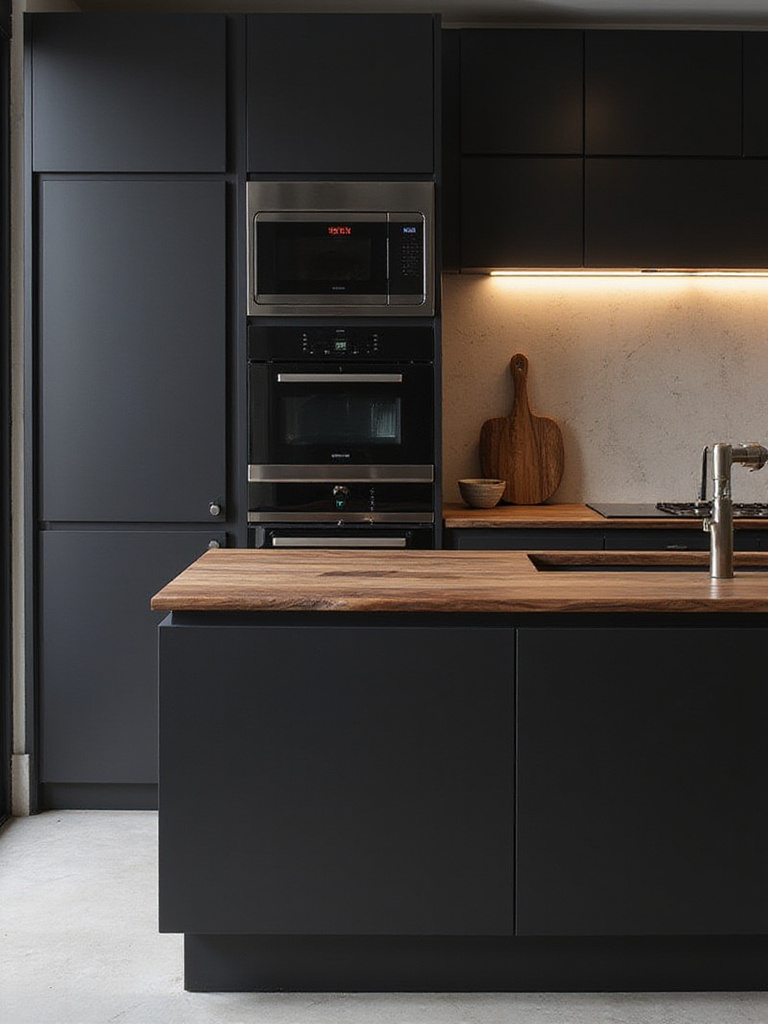
The type of wood you choose is critical. It’s a dialogue. Lighter woods like maple or birch can feel like soft morning light filtering through a shoji screen. Deeper tones like walnut or charred oak create a richer, more dramatic mood. I am particularly drawn to the traditional Japanese technique of shou sugi ban (or yakisugi), where wood is charred to preserve it. The resulting deep, crackled texture is breathtaking against a matte black cabinet. What’s important is to think about how these materials will age together. The black will remain constant, but the wood will develop a patina, a character, telling the story of your life in the kitchen.
This isn’t just about sticking a wooden countertop on black cabinets. It’s about intentional placement—a thick butcher-block island that invites touch, or open shelving that puts the wood’s grain on display. Every piece of wood should feel as if it has a purpose beyond just being beautiful.
3. Master Matte Black’s Contemporary Sophistication
There’s a quiet power to matte black that I find deeply compelling. It embodies the aesthetic of shibumi—a subtle, unobtrusive beauty that doesn’t feel the need to shout. Glossy surfaces reflect light and announce their presence, but matte black absorbs it, creating a sense of depth while remaining humble. This quality is perfect for kitchens where the goal is a sophisticated understatement, not flashy drama.
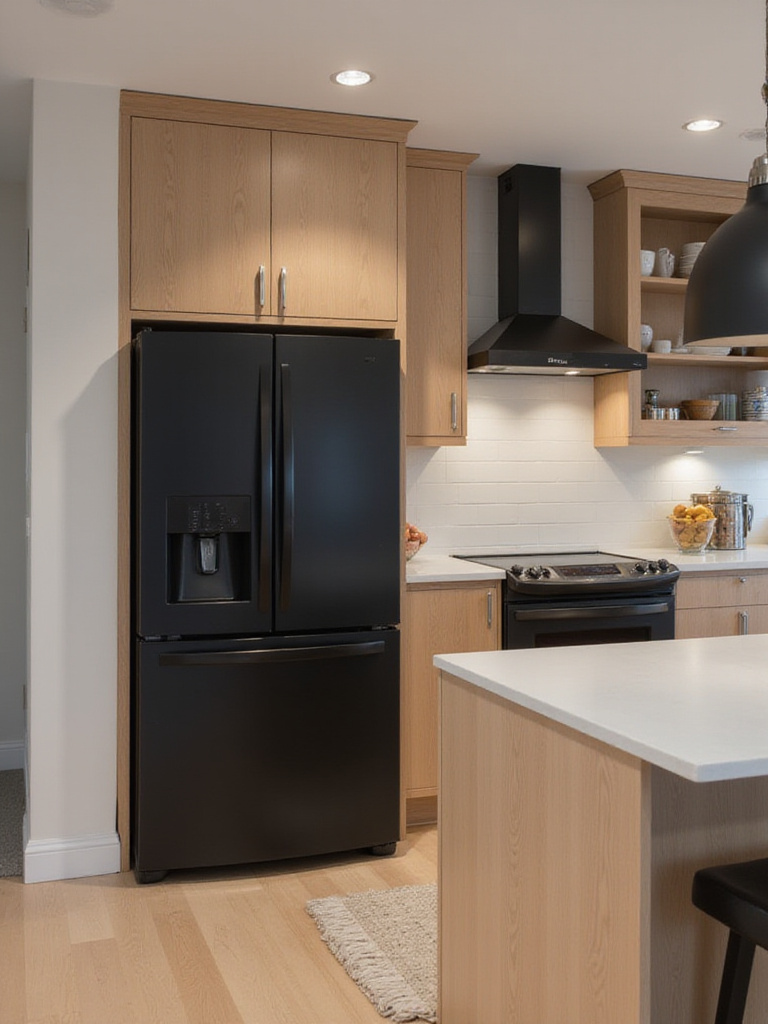
And frankly, there are practical benefits. Matte surfaces are wonderfully forgiving. They hide the fingerprints and water spots that can be a constant battle on high-gloss finishes. This acceptance of daily life aligns with the wabi-sabi idea of embracing imperfection. You can live in the space without feeling anxious about maintaining a flawless surface. Many modern matte finishes are also surprisingly durable and easy to clean, making them a genuinely practical choice for a busy home.
Of course, it’s about balance. You can’t just have a room full of light-absorbing surfaces. The trick is to pair matte black with elements that catch the light in different ways—a polished concrete floor, a few pieces of gleaming hardware, or a backsplash with a subtle sheen.
4. Create a Foundation with Black Shaker or Flat-Panel Cabinetry
The cabinetry is the architecture of your kitchen; it sets the fundamental character. Black shaker cabinets, with their clean lines and recessed panels, create a subtle play of shadows that shifts throughout the day. Flat-panel designs are even more minimalist, stripping away all ornamentation to focus purely on the quality of the material and the perfection of its proportions.
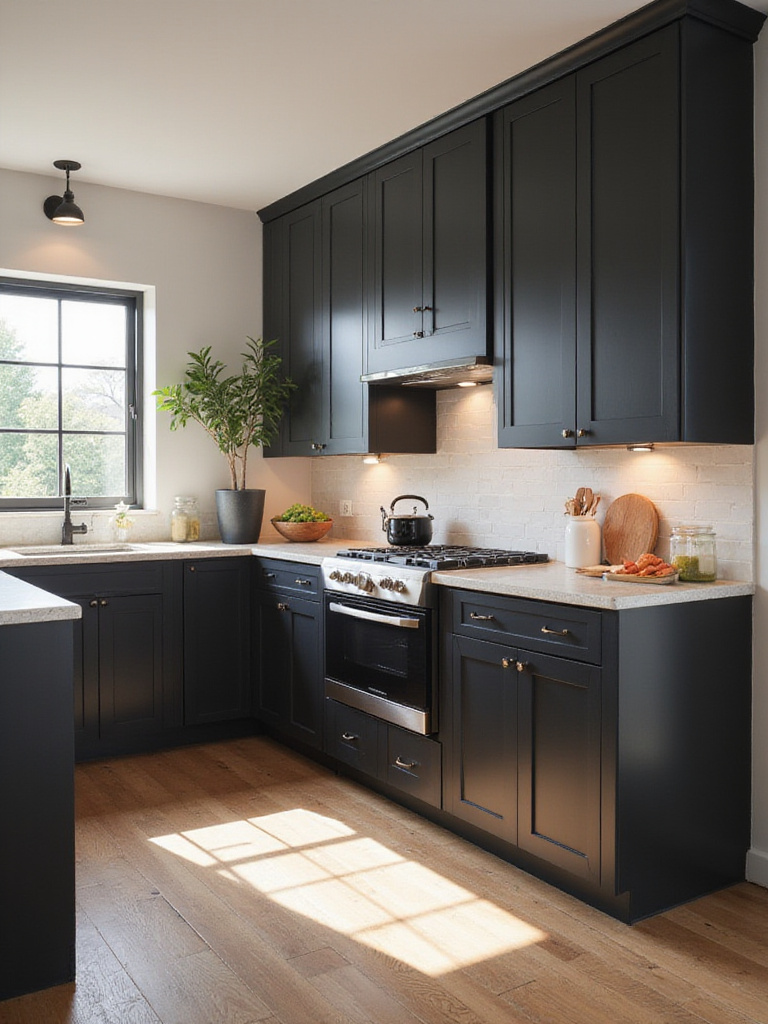
The choice between them is really a philosophical one. Shaker cabinets have a nod to tradition and craft, creating gentle geometric patterns that add interest without being fussy. Flat-panel cabinets are a pursuit of pure kanso, or simplicity. They aim for a surface so pure it becomes almost meditative. I’ve used both, and the decision always comes down to the feeling the client wants to cultivate.
With either style, the discipline of black demands that every detail contributes to the whole. The alignment of the doors, the feel of the hardware, the quiet operation of a hinge—these things matter more here. This is where the spirit of the shokunin, the dedicated artisan, comes into play. It’s a commitment to mastery in even the smallest, unseen details.
5. Anchor Your Design with Black Stone Countertops
Using black stone for countertops connects the kitchen to something ancient and elemental. It embodies a reverence for materials that carry the weight of geological time. Whether you select the consistent, deep black of an engineered quartz or the unique, wild character of a natural granite, these surfaces provide a sense of permanence and durability that feels grounding.

The finish of the stone changes everything. A polished black granite can act like a dark mirror, reflecting the light from a window and bringing unexpected brightness to the space. A honed or leathered finish, on the other hand, is all about texture. It absorbs light and invites you to touch it. I’ve noticed that people are drawn to these tactile surfaces; they can’t help but run their hands over them. These natural stones often have subtle mineral inclusions that catch the light in surprising ways, creating small moments of beauty.
There’s also a mindful aspect to caring for natural stone. It requires a certain level of attention—gentle cleaning, periodic sealing. This relationship between the user and the material, this act of care, fosters a deeper appreciation for the stone’s natural beauty and encourages a connection to the things we live with.
6. Integrate Seamless Black Appliances for Visual Continuity
When appliances disappear into the cabinetry, the kitchen as a whole becomes the focus. This reflects the design principle of mono no aware—a sensitivity to the subtle details that enhance an atmosphere rather than dominate it. When your refrigerator and dishwasher don’t shout for attention, the overall composition can achieve a state of calm and unified purpose.
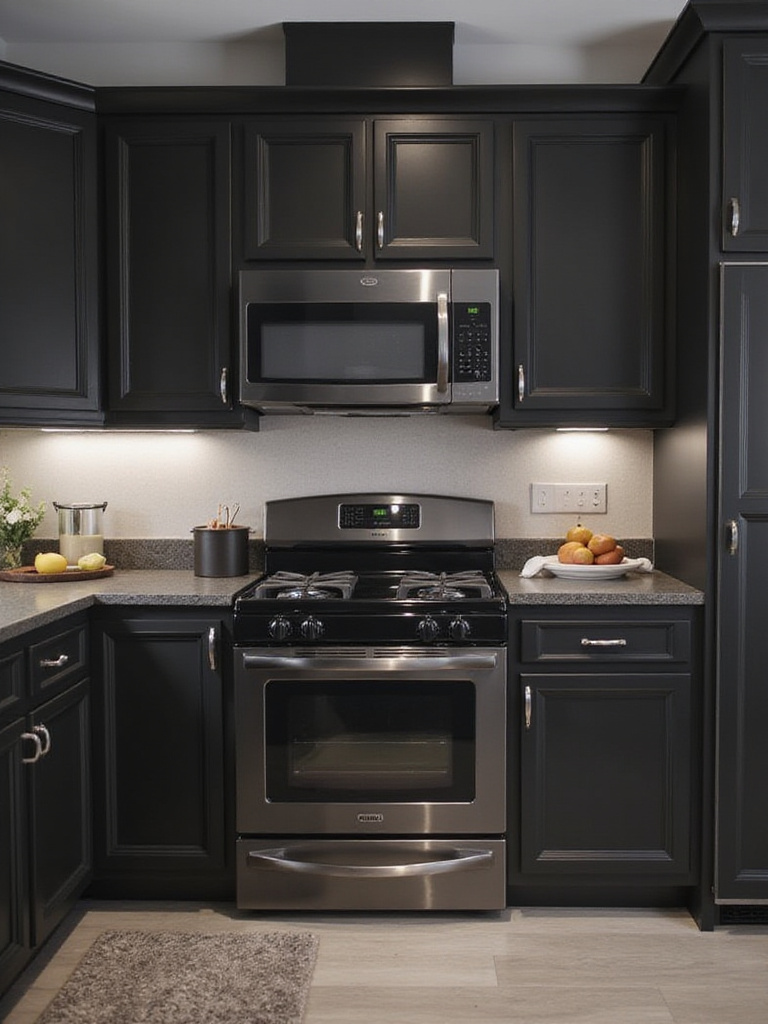
Modern black stainless steel is a far cry from the simple painted appliances of the past. The finishes are often created with coatings that are surprisingly resistant to fingerprints and scratches, making them both beautiful and practical. The goal is to have the appliances become part of the kitchen’s architectural fabric, not just machines sitting within it.
Panel-ready appliances are the ultimate expression of this idea, allowing you to cover them with the same material as your cabinets for a truly seamless look. This is where it gets tricky, as it requires meticulous planning with your cabinet maker. But the result is a kitchen that feels less like a workspace and more like a serene, integrated piece of furniture.
7. Design Textural Interest with a Black Tile Backsplash
The backsplash is where you can truly play with texture on an intimate scale. Think of it as the kitchen’s textile—the surface where pattern, finish, and the play of light create a rich visual experience. You could choose the handcrafted irregularities of Zellige tiles, the clean geometry of a subway pattern, or the pure, unbroken surface of a large-format slab.
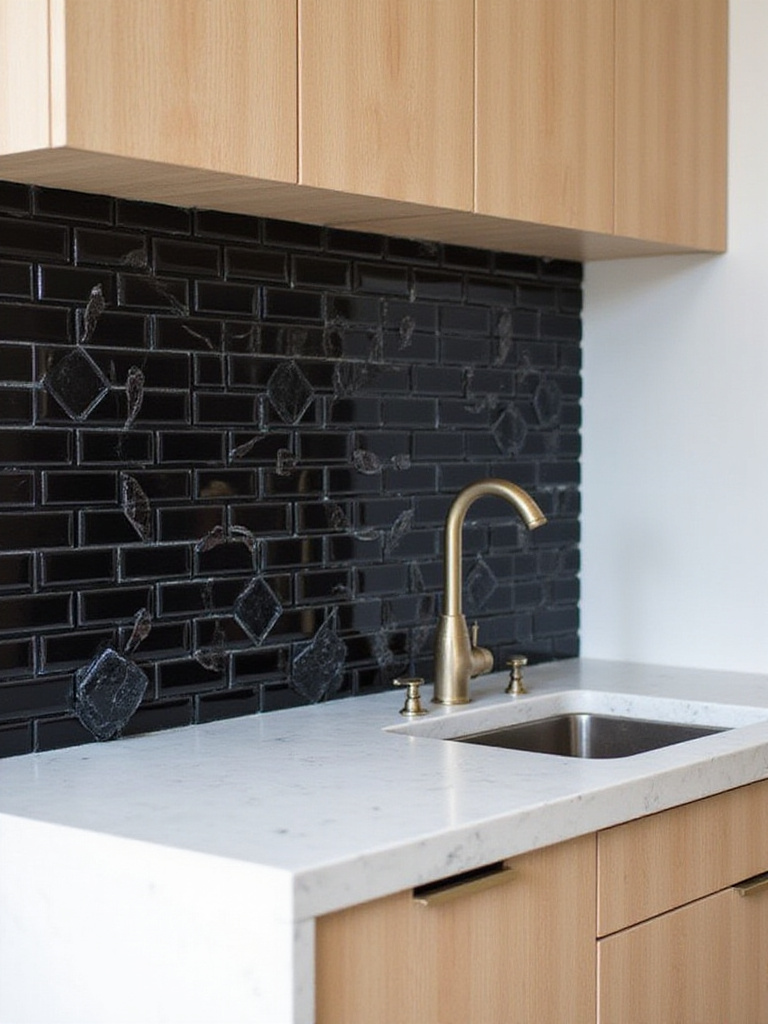
The choice should be guided by light. How will the surface look in the morning sun? How will it catch the under-cabinet lighting at night? Glossy tiles will create bright, reflective accents, while matte or textured tiles will absorb light and create a sense of depth. The grout lines themselves become part of the design, creating a rhythm and movement that can either calm the space or give it a subtle energy.
I believe the installation itself is an opportunity to express the spirit of shokunin, the craftsman’s devotion to their work. The precision of the grout lines, the careful turning of a corner—these small acts of dedication are what separate a good kitchen from a truly exceptional one. They reflect a deep respect for the materials and the process.
8. Establish a Foundation with Dark Flooring Materials
The floor is what grounds the entire design. Much like the raised platform of a traditional Japanese home, it defines the boundaries of the living space. In a black kitchen, dark flooring—whether large-format tile or polished concrete—can create a sense of uninterrupted flow that makes the room feel more expansive.
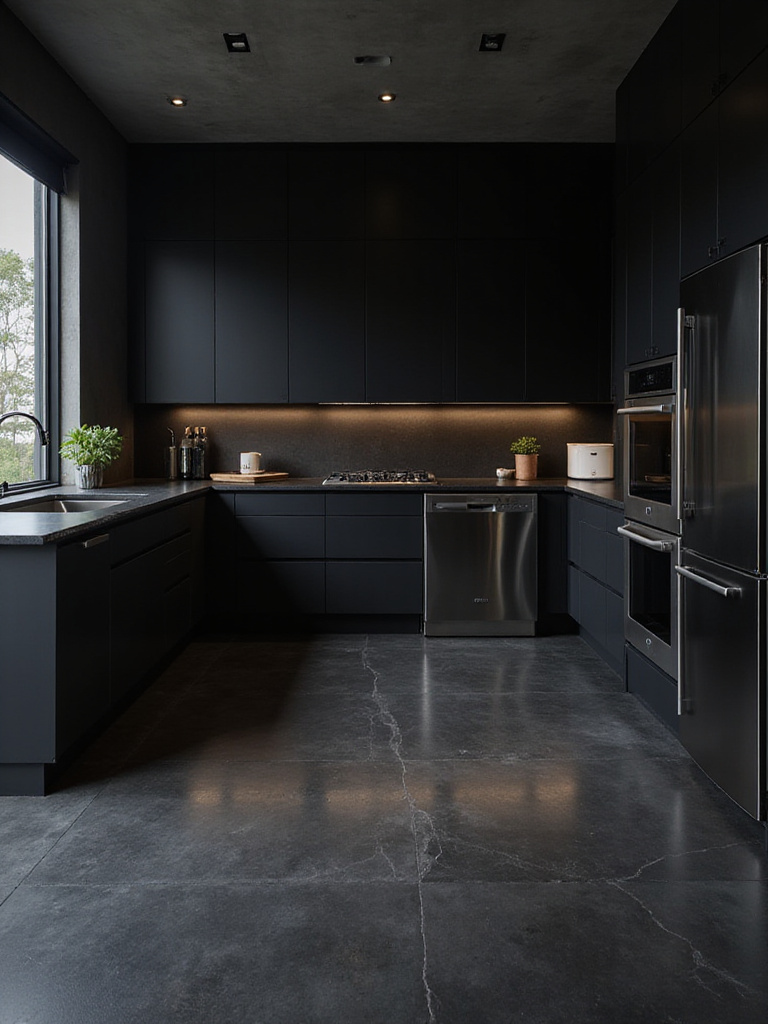
These materials each have a different character. Large-format porcelain tiles offer consistency and are incredibly durable and easy to maintain. Polished concrete, on the other hand, embraces an industrial aesthetic but can be customized with different aggregates and finishes to create a surface that is completely unique. It has a raw, honest quality that I find very appealing.
A common concern with dark, hard flooring is that it can feel cold. This is where a hidden luxury, like radiant in-floor heating, can make all the difference. It’s a form of invisible comfort, enhancing the daily experience without adding any visual clutter—a very Japanese approach to modern convenience.
9. Add Warmth with Contrasting Metallic Hardware
In a black kitchen, the hardware is like jewelry. These small elements have a huge impact, defining the overall aesthetic through their quality, finish, and form. Brass, copper, and bronze are my go-to choices. They provide a warm, metallic contrast that keeps the black surfaces from feeling too cold or severe, and they introduce a subtle touch of luxury that gets better with time.
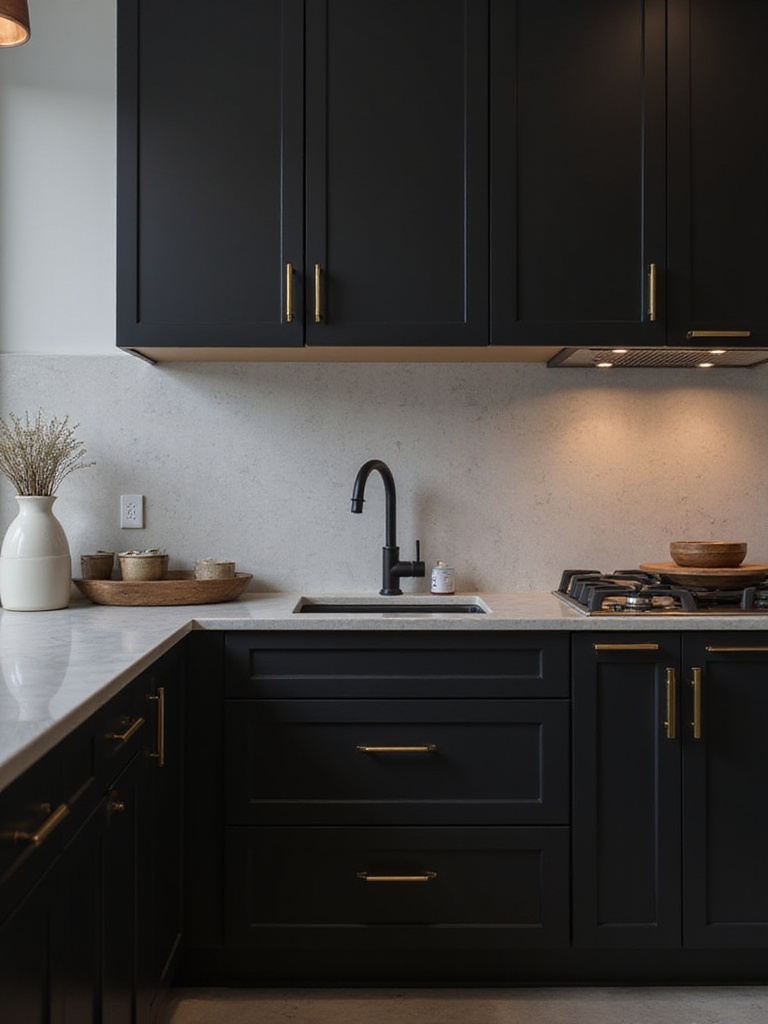
I especially love using unlacquered brass. It aligns beautifully with the wabi-sabi principle of valuing the beauty of aging. Over time, with the touch of your hands, it will develop a rich, unique patina. These changes aren’t a sign of decay; they are a record of your life in the space, telling a story of daily rituals.
The key is consistency. Choose a finish and carry it through all the hardware, from cabinet pulls to faucets. This isn’t just a finishing touch; it’s a decision that demonstrates a commitment to quality and a deep understanding of how small details contribute to the feeling of a space.
10. Layer Strategic Lighting for Depth and Function
Lighting a black kitchen is like designing a Japanese garden. It’s all about the interplay of light and shadow to create depth, mystery, and visual interest. A single, flat light source is the enemy here; it will make the space feel like a cave. Instead, you need multiple layers of light at different heights and intensities.

Under-cabinet lighting is essential. It provides bright task lighting right where you need it, and it also creates the illusion that the countertops are floating, which adds a wonderful sense of lightness. Pendants over an island or peninsula create a more intimate, focused light, defining a gathering space within the larger room. Finally, ambient light from recessed fixtures or cove lighting provides overall visibility, but it should be dimmable.
The quality of the light is just as important as the quantity. In a dark space, you need warm light—around 2700K to 3000K. It complements the sophisticated atmosphere. Cooler light can feel harsh and clinical. And always, always use dimmers. The ability to change the light level allows the kitchen to adapt, moving from a bright, functional workspace to a relaxed, intimate setting for an evening meal.
11. Upgrade to a Sophisticated Black Composite Sink
The sink is one of the hardest-working parts of any kitchen, so its material is crucial. Black composite sinks, made from granite or quartz particles, offer a way to seamlessly integrate this element into the design. They blend in with dark countertops while providing fantastic durability and stain resistance.

These modern materials really do combine the best of both worlds. They have the substantial, earthy feel of natural stone, but the non-porous surface resists stains and is incredibly hygienic. They can also handle a hot pan without any issue, which is essential in a kitchen that is meant to be used.
When you pair a black composite sink with a faucet in a complementary finish, like matte black or warm brass, the sink area transforms. It stops being a purely utilitarian zone and becomes a thoughtful, integrated part of the overall design. It’s another one of those details that signals a commitment to quality materials.
12. Layer Rich Textures for Sensory Depth
When you limit the color palette, texture becomes your language. It’s how you create contrast and complexity. Introducing materials like leather, velvet, woven fibers, or different stone finishes adds a sensory richness that makes a space feel inviting and luxurious, rather than cold and stark.
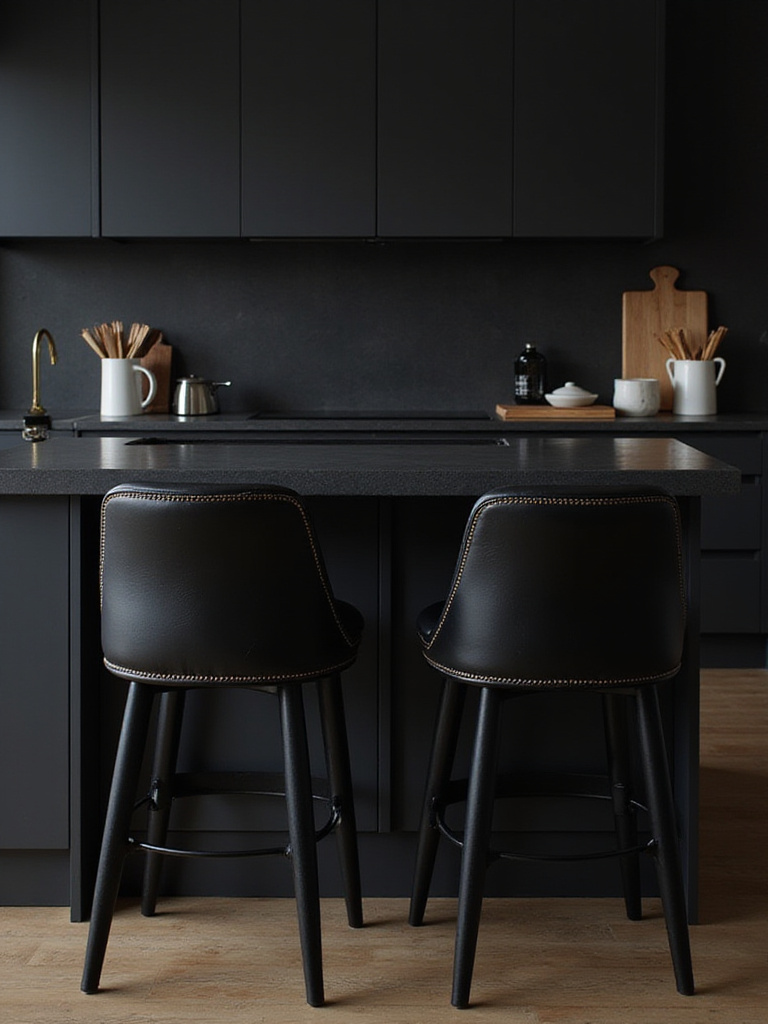
Every texture can serve a purpose. Leather on a bar stool provides comfortable seating and is a material that only gets better with age. A woven jute rug can connect the kitchen to natural, handcrafted traditions while adding softness underfoot. Even something like velvet cushions on a window seat can absorb sound and add a visual weight that balances all the hard surfaces.
Think about how these different materials will interact with light and shadow. A smooth surface reflects light, creating bright spots. A heavily textured material absorbs it, creating depth. It’s the interplay between these qualities that creates a subtle complexity, a space that rewards you the closer you look.
13. Create Drama with a Strategic Black Accent Wall
A single black accent wall can function like a tokonoma in a traditional Japanese home—a designated alcove that creates a focal point for contemplation. It’s a powerful tool for adding depth and drama, and it provides a backdrop that makes other elements—art, open shelves, even a simple vase of flowers—appear more vivid and significant.
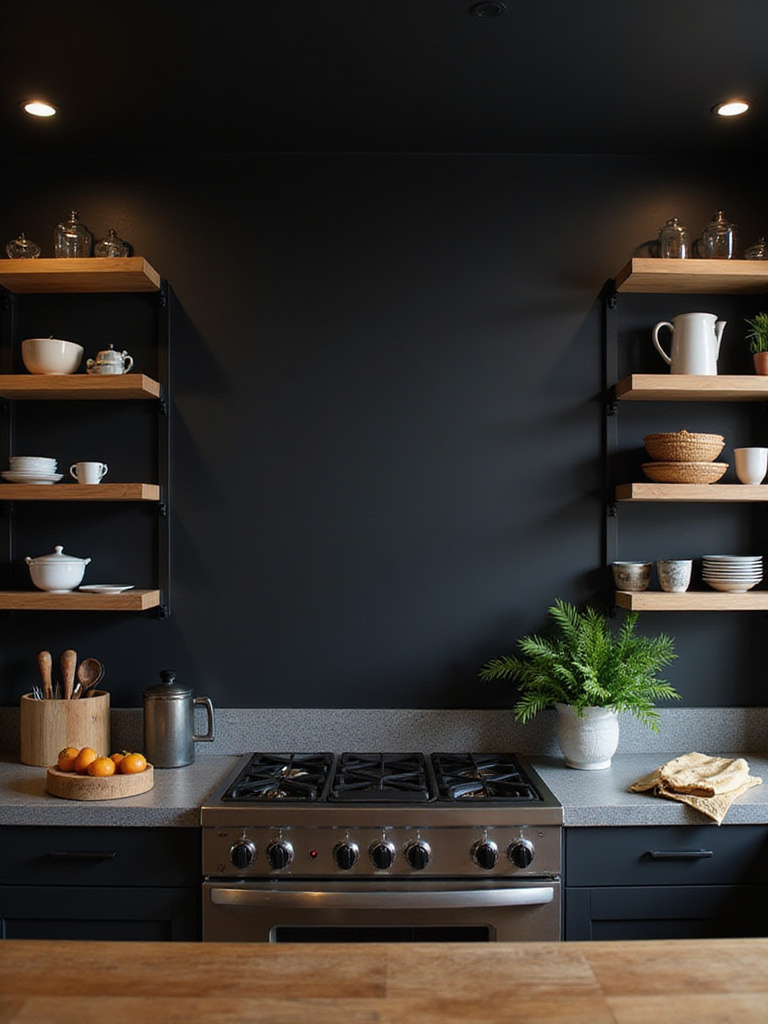
Placement is everything. You need to understand the room’s flow and its natural light. A black wall opposite the main entrance has an immediate, dramatic impact. A wall behind open shelving can create a gallery-like feel. The finish is also key. A deep matte paint, a textured wallpaper, or even panels of charred wood will each interact with the light in a completely different way.
There’s a psychological effect at play, too. A dark surface recedes from the eye, which can actually make a space feel larger while also creating a sense of intimacy. This duality—feeling both expansive and protective—is a core concept in creating spaces that feel truly harmonious.
14. Curate Open Black Shelving for Display and Function
Open shelves in a black kitchen are not just for storage; they are for curated display. I think of it like the careful arrangement of utensils in a tea ceremony—every object has a functional purpose, but it is also chosen for its aesthetic beauty. The dark background makes everything placed upon it stand out, turning everyday items into a visual composition.
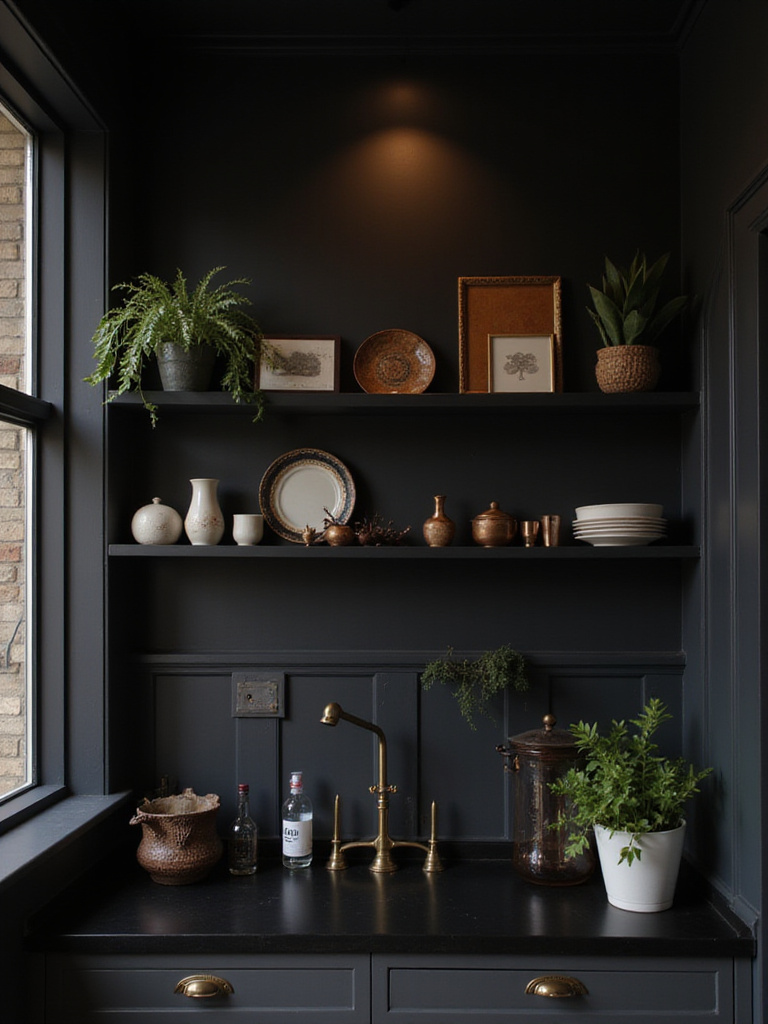
This requires discipline. Every object has to earn its place. Simple white ceramics, a beautiful wooden cutting board, or gleaming copper pots create a stunning contrast. But the most important element is the empty space between the objects. In Japanese design, this is ma, the pause. It’s the breathing room that prevents visual clutter and allows each object to be appreciated on its own.
My advice is always to start with less than you think you need. You can always add more later. Group objects in odd numbers, vary their heights and shapes, and treat the shelves as a three-dimensional piece of art that evolves with your daily life.
15. Introduce Vibrant Color Through Strategic Accents
In a black kitchen, a little bit of color goes a long way. Think of it like a single, perfect flower in a minimalist arrangement. Its power comes from its restraint. The dark, neutral background intensifies any color you introduce, making even a small touch of a vibrant hue feel more saturated and impactful.
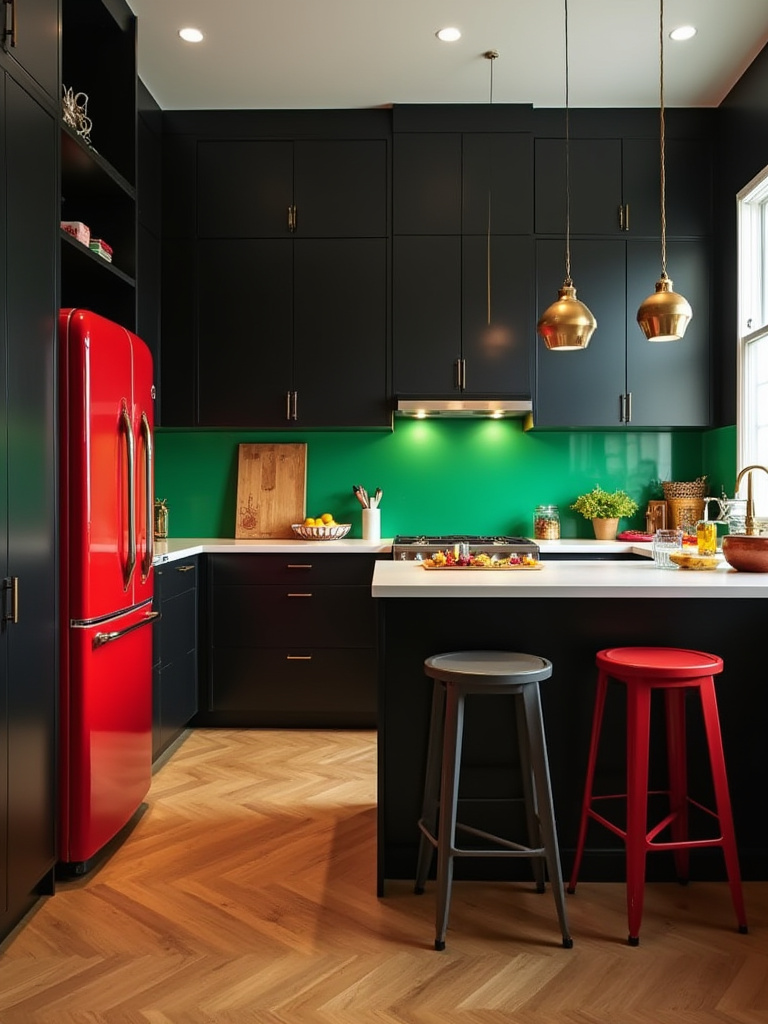
I suggest starting with things that are easily changed. Textiles, a piece of artwork, or a collection of decorative objects allow you to experiment with color without making a permanent commitment. This way, the space can evolve with the seasons or with your own changing tastes.
Honestly, some of the most effective color accents are the most natural ones. A bowl of bright green limes, a pot of fresh basil on the windowsill, or a vase of seasonal flowers introduces an organic, living color that changes over time. This aligns with the principle of celebrating the cycles of nature, and it has the practical benefit of keeping fresh ingredients close at hand.
16. Enhance Function with Sophisticated Black Seating
The seating in your kitchen has to work hard. It needs to be comfortable for daily use while also contributing to the overall design harmony. Black bar stools or dining chairs can provide that visual continuity, creating a seamless look while also offering an opportunity to introduce new textures and materials.
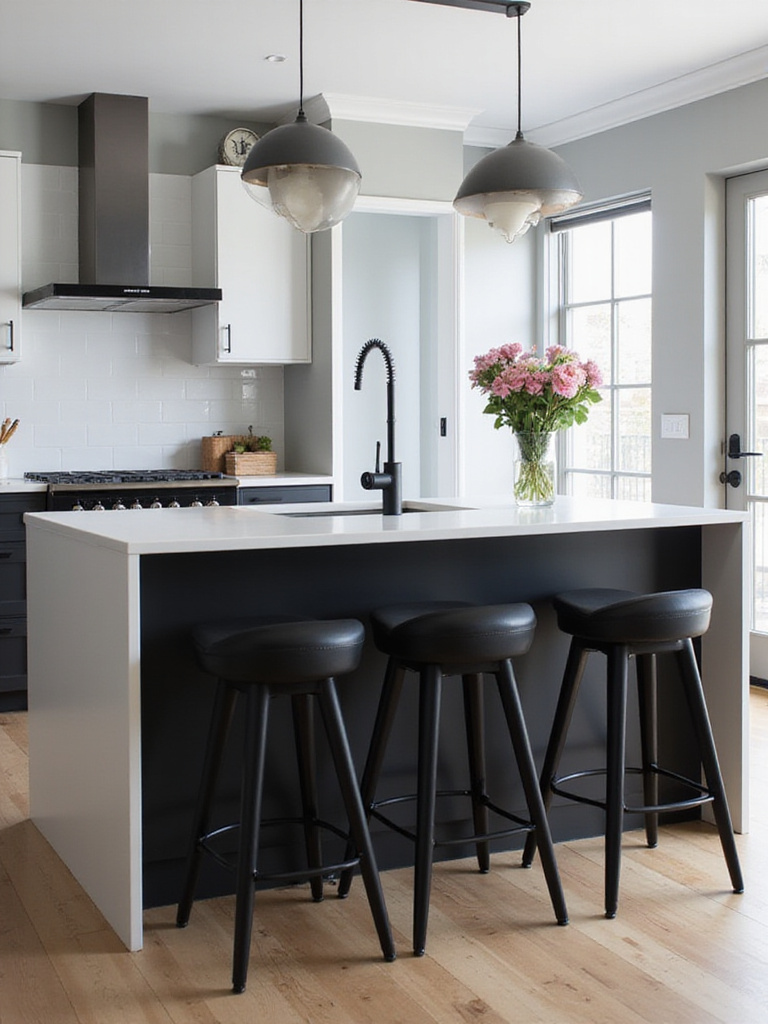
The proportions have to be right. It’s a common mistake I see—seating that is too large or too small for the island or table. This throws off the balance of the entire room. You have to consider not just the seat height, but also the visual weight of the piece. Does it feel light and airy, or heavy and grounded?
This is another area where you can play with subtle variations on the black theme. A matte metal frame with a worn leather seat, an upholstered back with dark wooden legs, or a fully upholstered chair in a textured black fabric—each choice changes the character of the seating and how it contributes to the room’s composition.
17. Integrate Living Elements Through Strategic Plant Placement
Plants in a black kitchen are like “borrowed scenery” in a Japanese garden. They connect the interior space to the natural world and provide a soft, organic contrast to the hard architectural lines. The deep, dark background makes green foliage appear incredibly vibrant and alive.
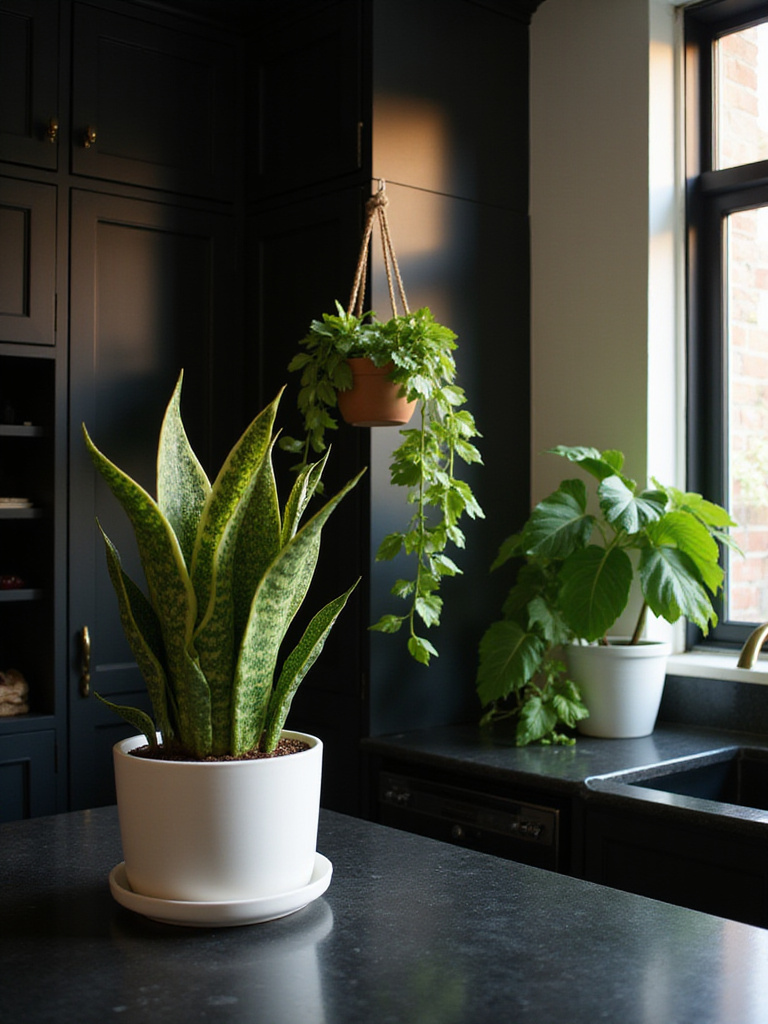
You have to be strategic. Think about the conditions in your kitchen—the temperature changes, the humidity, the available light. Hardy plants like snake plants or pothos are often a good choice. I particularly love incorporating herbs. Pots of rosemary, thyme, or mint not only add a touch of green but also contribute to the sensory experience of the kitchen with their fragrance.
Placement can help define the space. A large floor plant can anchor a corner, while a small, delicate plant on a shelf can create an intimate moment of beauty. Hanging plants are wonderful for drawing the eye upward and adding a sense of verticality, softening the hard edges where walls and ceilings meet.
18. Maximize Natural Light for Balance and Vitality
Natural light is the life force of a black kitchen. It’s what keeps the space from feeling heavy and reveals the subtle beauty of the materials. The dynamic interplay of light and shadow throughout the day is what brings a room to life, creating a drama and depth that artificial light can never fully replicate.
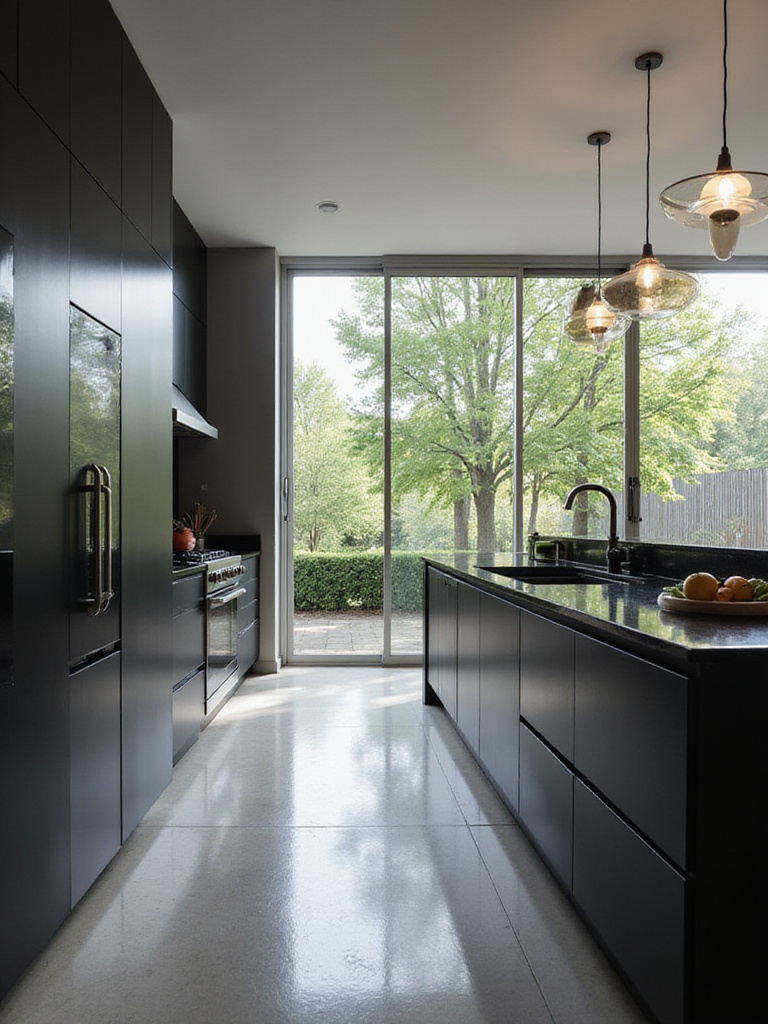
Window treatments, if you need them at all, should be minimal. Simple roller shades or sheer panels that diffuse the light without blocking it are ideal. The goal is to frame the view and control glare, not to obstruct the flow of natural light that makes dark surfaces feel rich and velvety.
You can also use reflective surfaces to amplify the light you have. A polished countertop, a glossy backsplash, or even a few well-placed metallic accessories can catch the light from a window and bounce it deeper into the room. This balance between matte and reflective finishes is key to creating a space that feels both complex and illuminated.
19. Express Personality Through Curated Art and Accessories
Art and accessories are what make a space truly personal. In a black kitchen, these objects are given a gallery-like stage. The dark background makes colors pop and textures stand out, transforming the kitchen from a purely functional space into one that also provides visual and emotional nourishment.
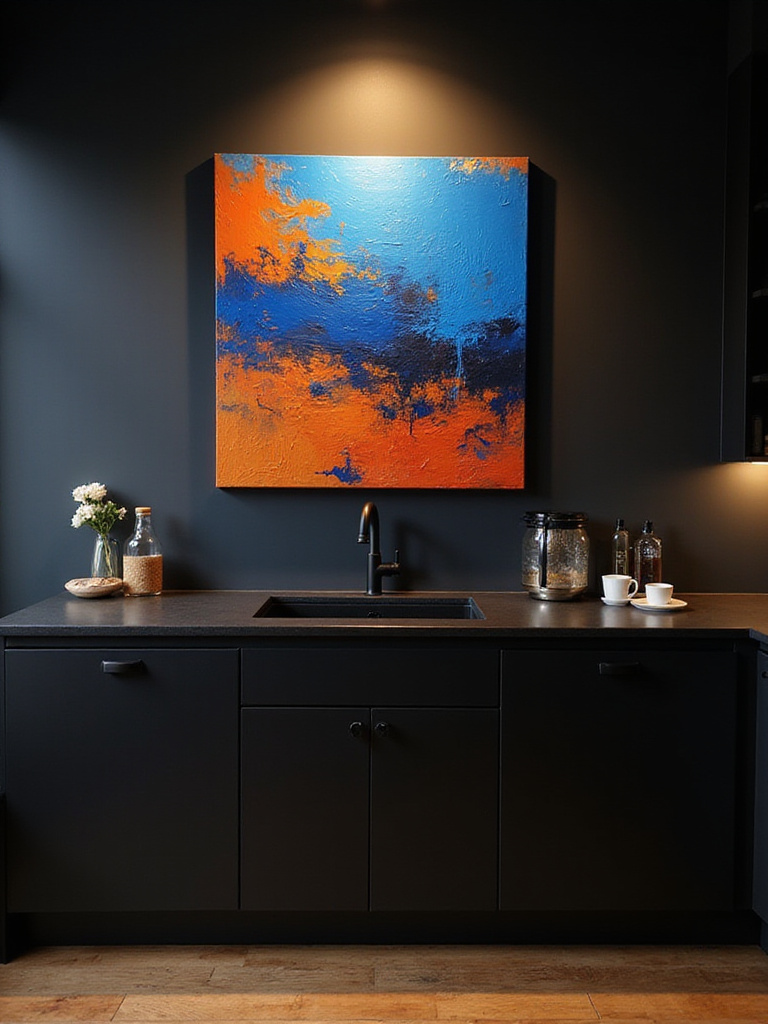
Curation is a discipline. It’s not about filling space; it’s about choosing pieces that have personal significance and aesthetic merit. A single large-scale photograph can create a dramatic focal point. A small, thoughtful grouping of handmade ceramics can create a quiet moment of beauty. What’s important is that each piece earns its place.
Think about how the art will be lit. Will it catch the morning sun? Will it be highlighted by a spotlight at night? And remember to balance permanent pieces with things that can be changed. This allows your kitchen to evolve with you, reflecting your experiences and your journey.
20. Maintain Pristine Beauty Through Mindful Care
Caring for a black kitchen can be a meditative practice. It reflects the Japanese principle of omotenashi—a spirit of wholehearted hospitality and respect that extends to one’s environment. Understanding how to care for the specific materials in your kitchen ensures they retain their beauty for years to come.
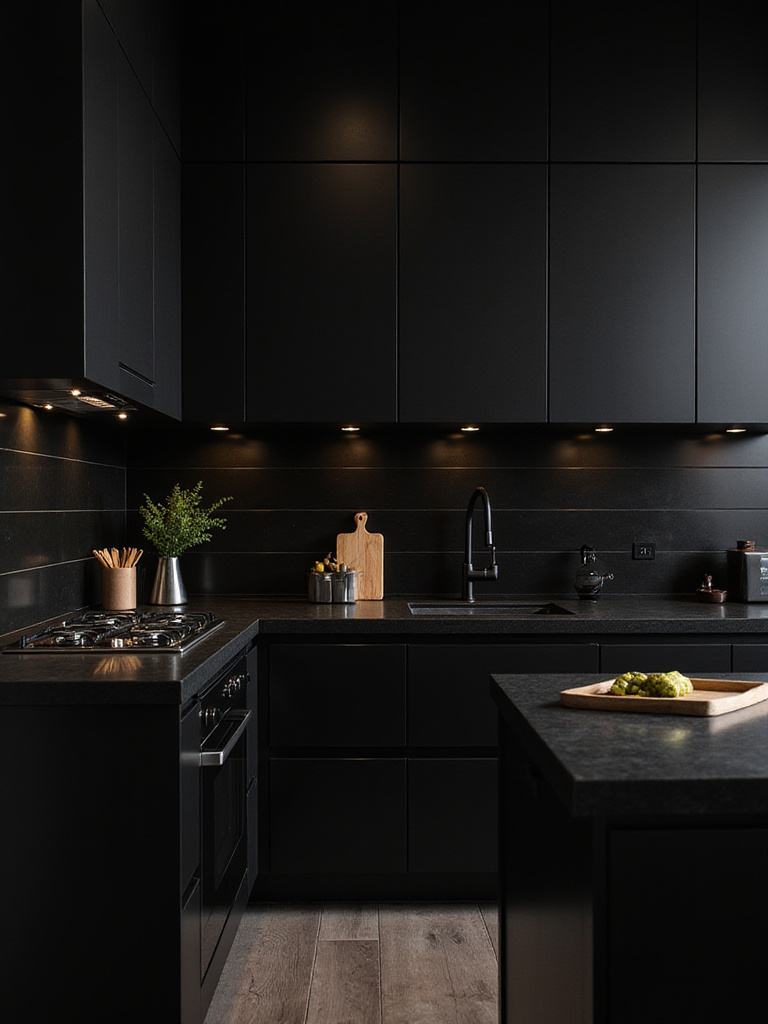
This doesn’t have to be a chore. I encourage clients to integrate these small acts of care into their daily routines. Wiping down surfaces after you use them, using the right cleaners for each material—these are mindful actions that foster a connection to your home.
Over time, you’ll learn how different materials respond to use. Natural stone may need to be resealed, and a painted surface might need a small touch-up. Approaching these tasks with attention and care, rather than seeing them as a burden, becomes an opportunity to appreciate the quality of the materials and to maintain a harmonious relationship with your surroundings.
Conclusion
This journey through the world of black kitchens is really an exploration of a different way of thinking about space. It’s a move away from the idea that a room must be bright and full of things to be beautiful. It teaches us how darkness can illuminate, how quiet restraint can feel incredibly rich, and how a thoughtful orchestration of materials can turn the most practical room in the house into a sanctuary for the spirit.
A black kitchen is more than just a style. It becomes a stage for the daily rituals of life, where the simple act of preparing a meal can feel like a meditative practice. It’s a space that nourishes the body, but also the soul.
If this resonates with you, my advice is to start small. You don’t have to commit to everything at once. Begin with one or two elements that speak to you—the deep foundation of black cabinets, the warm touch of natural wood, or the quiet luxury of brass hardware. Each choice is a step toward creating a kitchen that will not only serve you well but will also deepen in beauty and meaning over time.
